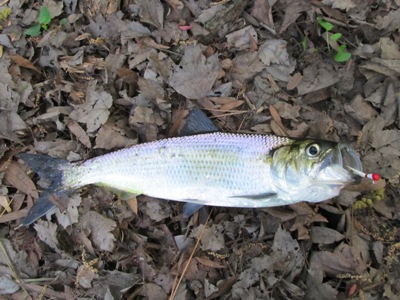
Hickory shad are found throughout the Mid Atlantic although their presence in an area is usually seasonal.
In early spring, hickory shad migrate from inshore saltwater up rivers and creeks. Some fish travel great distances in order to reach their natal spawning areas.
During their spring spawning migrations, hickory shad are sometimes found together with American shad and river herring.
As hickory shad move through the upper reaches of creeks and streams, anglers target them using a variety of small lures.
The traditional lure for catching shad and river herring is the shad dart. Anglers also catch hickory shad with small jigs, inline spinners, flies, and other lures. Anglers that specialize in catching shad often rig 2 jigs in tandem. Tandem rig variations may include matched jigs or any combination of sizes, colors, or styles.
Anglers occasionally encounter hickory shad during summer thru fall in the Chesapeake Bay, coastal bays, or other inshore areas. Large schools of shad are sometimes seen on the surface, especially in early morning or late day. In saltwater, hickory shad are usually an incidental catch, although a few anglers are able to recognize them and will intentionally fish for the species when opportunities arise.
Although hickory shad may be difficult to locate during the summer season, they are sometimes easy to catch with the correct tackle. Hickory shad are caught around inlets, rips, and channel edges using small, shiny jigs casted on light outfits. They readily take flies and are a favorite species among saltwater fly anglers.
Hickory shad are managed cooperatively by the Atlantic States Marine Fisheries Commission (ASMFC) through the Interstate Fishery Management Plan (FMP) for Shad and River Herring.